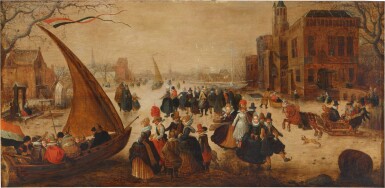Old Masters Evening Auction
Old Masters Evening Auction

Property from the Collection of Jacques Goudstikker
Adam van Breen
Winter landscape with numerous elegantly-dressed figures skating on a frozen river, with an ice yacht
Auction Closed
July 6, 06:35 PM GMT
Estimate
70,000 - 100,000 GBP
Lot Details
Description
Property from the Collection of Jacques Goudstikker
Adam van Breen
The Hague 1590-1645
Winter landscape with numerous elegantly-dressed figures skating on a frozen river, with an ice yacht
oil on oak panel
46.5 x 95 cm.; 18¼ x 37⅜ in.
---------------------------------------------------
知名荷蘭藝商雅克・古德斯蒂克舊藏
亞當・凡・布林
1590 - 1645年,海牙
《冬日景致:在結冰河面上溜冰的優雅男女與一艘冰上滑艇》
油彩橡木畫板
46.5 x 95 公分;18¼ x 37⅜ 英寸
Kees Hermsen, New York, or Dorus Hermsen, The Hague;
With Jacques Goudstikker (1898–1940), Amsterdam, inv. no. 2659, acquired from the above before 1931, until May 1940;
When aryanised by Reichsmarschall Hermann Göring, Berlin;
Dr Martin Schunck (1900–1987), Trier, acquired in September 1940;
Stadtmuseum Simeonstift, Trier (bequeathed to the museum from the Estate of the above in 1987);
Restituted to the heir of Jacques Goudstikker by the above in 2022.
This painting represents one of Adam van Breen’s most popular compositions, which are among the very earliest examples of the ‘winter landscape’ – a subject that developed through the 15th and 16th centuries to become a quintessentially Dutch genre in the 17th century, at a time when, during the so-called ‘Little Ice Age’, The Netherlands experienced several years of particularly severe winters. Works such as this celebrate the pleasures to be gained from such conditions, however, depicting not only the pastimes associated with myriad frozen waterways, but also the heights of fashion in dress and modes of transport.
Van Breen may have been trained in Amsterdam by David Vinckboons, with whom his works – including this one – have often been compared and indeed confused. While there, he must also have encountered paintings by Hendrick Avercamp, who specialised in winter landscapes. In The Hague, Van Breen was probably most influenced by Adriaen Pietersz. van de Venne, who was working for the Stadthouder’s court, and whose highly elegant and fashionably dressed figures likewise find strong echoes here, where the figures appear to hail exclusively from the nobility and bourgeoisie, dressed in the finest clothing of the day. These outfits have been dated by Marijke de Kinkelder to circa 1615.
Three other versions, all with numerous differences in the composition and staffage, are dated between about 1610 and 1620. The earliest is probably the painting in the Rijksmuseum, Amsterdam (inv. no. SK-A-2510), which is dated 1611.1 That painting depicts fewer figures, which are more widely-spaced than here, and the background landscape is of a completely different design. More closely related to the present picture, though still with many variations, is the work last seen at Sotheby’s, London, 25 June 1969, lot 129 (when it was sold as Adriaen Pietersz. van de Venne),2 and the painting, even closer in composition to this version, in the Museum Thyssen-Bornemisza, Madrid, where it is considered to be by David Vinckboons, albeit without obvious justification.3
The dominant motif common to all these versions is the ijszeilboot (ice yacht) on the left. These were small, flat-bottomed sailing boats, adapted for the frozen rivers and canals with strong, transverse planks with runners at each end affixed to the base to carry most of the weight of the craft, with additional longitudinal runners at the bow and stern, as well as a steering device (though the example here does not display these features). One such ice yacht, with a more sophisticated rig than the vessel seen here, occurs in a winter landscape by Van de Venne of 1614, today in the Gemäldegalerie, Berlin (inv. no. 741B),4 and they are also to be found in the backgrounds of winter scenes by perhaps the greatest proponent of the genre, Hendrick Avercamp.
For further discussion of the artist and the development of the ‘winter landscape’, see lot 13.
Note on Provenance
This painting is historically important as one of over 1,400 works appropriated from the Jewish, Amsterdam-based art dealer, Jacques Goudstikker, during the Second World War. Goudstikker was one of the most successful art dealers of his time, and worked with a number of prominent collectors, including Edwin vom Rath and Detlen van Hadeln, both of whom bequeathed their collections to the Rijksmuseum. Goudstikker managed to escape Amsterdam with his wife and son in 1940, but died on board ship on the way to South America. Herman Göring, meanwhile, contrived a series of forced sales with Alois Miedl, who took over the gallery. The extraordinary survival of Goudstikker’s meticulously recorded inventory in a black notebook itemising every work in his vast stock, which was recovered from his body after his death, has been an invaluable source in tracing and restituting works formerly in his possession. In 2006 over 200 of Goudstikker's pictures (representing only a fraction of his dispersed collection), which had been handed over to the Dutch state in 1946, were restituted to his daughter-in-law, Marei von Saher, and the present painting is one of a number of works that have been restituted since that time.
1 https://www.rijksmuseum.nl/en/collection/SK-A-2510
2 https://rkd.nl/explore/images/66645
